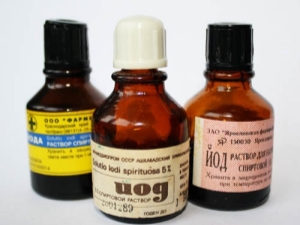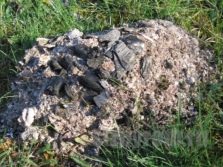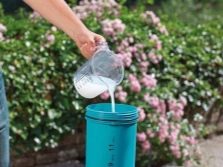How to use iodine for tomato seedlings?

Everyone wants to have tasty and healthy vegetables on his desk.But unfortunately, not all fruits grown on their own will meet these requirements. As for tomatoes, the familiar results will help to achieve the desired result, among which iodine should be highlighted, which is sold in any pharmacy.
Beneficial features
A decent crop of tomatoes depends on proper plant care. Most experienced gardeners recommend iodine as a top dressing for their health. The use of this medicine in the right proportions will serve the plants only for good. Iodine is used both for seedlings of tomatoes, and for planted tomatoes in a greenhouse or in open ground. In any of these options, it provides water to the plants, contributing to their proper development and strengthening.
Everyone knows that the most delicious tomato is the one that is grown by hand. The main advantage of self-care is to control the entire process of growth and maturation of the culture. In addition, the question of fertilizer can be approached with all the responsibility.
It has been proven that iodine has a beneficial effect on plant organisms, but it is not a vital element. In small doses, it has a stimulating effect on tomatoes, but its excess for crops will be toxic. Therefore, the use of the tool is reasonable.
As for the person, eating tomatoes, for which iodine was used as a fertilizer, is very beneficial for health, because the fruits of plants will contain the required amount of trace elements for people.
Using the composition for plants, the latter have positive dynamics associated with nitrogen metabolism, since iodine acts as a worthy alternative to nitrogen fertilizers.
In addition to the above useful properties of iodine, which relate to the growth and development of plants, it should be noted that this pharmaceutical preparation allows you to successfully fight various types of fungi and other harmful microorganisms that reproduce not only in the plant itself, but also in the soil.
The lack of iodine in tomatoes can be determined by their too slow development, in addition, the culture shows various signs indicating its disease.
To prevent an excess of iodine, one should know in which soil it is present the most. The following types of soil can be distinguished:
- black soil and red soil;
- chestnut soil;
- tundra peatlands.
In addition, iodine is present in natural fertilizers, which are often used for growing vegetables and fruits in their own gardens and suburban areas. These include such compounds:
- peat and peat ash;
- manure;
- wood ash.
Proper use of iodine at home will allow to feed the tomatoes from the very beginning of their growth and until the ovaries appear.
What is it needed for?
Iodine as an element in the development of tomatoes is a catalyst, due to which the plant's ability to absorb nutrients is improved. In addition, it has a positive effect on the protective properties of the culture, which excludes the development of various pathologies.
There are several methods of plant nutrition: feeding the root system from the soil and spraying the leaves and stem.
It is necessary to highlight the main benefits of fertilizing tomatoes with iodine:
- the tool helps to strengthen the immune system, and is also a preventive compound that protects against various diseases of vegetables, because it is proved that such tomatoes rarely have viruses;
- protects fruits from mushrooms;
- acts as a substitute for some fertilizers, for example, nitrate;
- iodine improves soil, increasing its fertility;
- If you fertilize tomatoes with iodine, the plant will better absorb other useful elements from the air and soil;
- starting to water with a solution of iodine seedlings of tomatoes, it is possible to achieve earlier flowering and ripening of fruits;
- the tool improves the quality of tomatoes in general;
- the treatment of the seedlings with the composition prevents its stretching, less often there is a listlessness of the leaves;
- Iodine is an effective means of controlling late blight.
Comparing a vegetable crop such as a tomato with other plants, it is worth noting that it urgently needs fertilizing, therefore, processing is required even for healthy plants.
Iodine deficiency in tomatoes can be identified by a number of signs:
- seedlings look faded;
- the stems of the plant are very thin;
- tendency to various putrefactive diseases of the root system.
However, to have an idea about the benefits of the element for the plant will not be enough, because an extremely important point is the correct preparation of tomato feed containing iodine, because its excess will lead to negative consequences.
Experts use two methods to saturate the plant with this composition: root and foliar top dressing. To achieve the most positive result, the above methods should be used alternately. Thus, it is possible, if necessary, to achieve a therapeutic result, or to use fertilizer for preventive measures, which have a rather prolonged effect.
Recipes
There are several popular and effective ways to prepare the composition, including iodine. The element diluted correctly in water will not be poisonous to either the soil or the plants, since its concentration in the total volume of the solution will be minimal. This completely eliminates the risk of burning the leaves or root of a tomato.
To heal the seeds, the iodine-containing composition is prepared according to the following method: one drop of iodine is dissolved in one liter of water. It is pre-soaked material before landing for six to seven hours. In this case, the element acts as an antiseptic: it disinfects the culture, and also activates its growth.
However, it is worth paying attention to the fact that the planting material covered with a multi-colored sheath is not necessary to soak before planting.
To feed the plants after the first feed with mineral fertilizers, a solution is prepared for irrigation using one of the methods described below.
In the first case, the composition is prepared not only with water but also with milk. For the preparation will need half a liter of milk, two liters of plain water and two drops of iodine.
In the second variant, the fertilizer needs to dissolve one drop of iodine in three liters of water.
The technology of irrigating tomatoes with these means is to work with a watering can with a strainer. It is necessary to moisten the soil and foliage of tomatoes a little.
It is worth noting that such treatment is needed only once.
As for watering the soil before planting seedlings, for this purpose a solution with a useful element is prepared as follows: three drops of iodine are diluted in ten liters of water, after which the soil is well watered. This work should be done about a day before planting. The need for such irrigation of soil is due to the ability of the element to disinfect the soil for plants that have not yet become stronger, which will positively affect their adaptation.
Processing of tomatoes from late blight is carried out with a compound that is prepared according to the following recipe:
- a liter of whey is added to a bucket of water;
- then 40 drops of alcohol tincture of iodine;
- as the last component is hydrogen peroxide, it is necessary to add one tablespoon.
This composition is necessary to treat the seedlings of tomatoes.
Some gardeners use a different compound to combat vegetable disease. According to experienced gardeners, it has great efficiency, and also provides stable immunity in plants.
The treatment solution is prepared according to the following scheme:
- in eight liters of boiled water injected two liters of ash powder and mix well, allow to cool;
- after that, a vial of iodine and ten grams of boric acid is added to the resulting composition;
- the mixture should be brewed for about twelve hours;
- Further, such a composition for the treatment of plants is diluted with water in proportion: one liter of substance per bucket of water.
As time passes, the crop is watered to the root. Since the resulting solution contains a lot of useful substances, it can be used as the main fertilizer for tomatoes. However, during the preparation, you should strictly follow the recommendations regarding the amount of the introduced element, since excess iodine can disrupt the natural course of the formation of culture brushes. As a result, the fruits will have a curved shape.
How to feed?
There are several ways to feed tomatoes with iodine-containing composition.
Root
Such watering should be carried out after a few leaves appear on the crop. During this period, the tomatoes will be very welcome additional introduction of beneficial trace elements. In this case, use a solution of low concentration: it will be enough to dilute one drop of iodine in three liters of water. This amount of element will be enough for a young plant. Root irrigation is carried out for each plant at the very root, thus it will turn out to saturate the culture with a good portion of useful substances. In addition, the positive effect of the described method of watering is doubled, because along with iodine the tomato gets the much-needed water.
After some time, when the ovaries begin to form on the bushes, you can perform a second feeding of tomatoes. In this case, the solution is prepared in slightly different proportions: it is recommended to inject three drops of iodine for every ten liters of water. It is important that the water had a room temperature.
The optimal amount for one plant bush is one liter of composition. 600-700 ml will be enough for undersized varieties of tomatoes.
The next fertilizer plant needs at the stage when the culture begins to bear fruit. In this phase, a solution with an even higher content of the element should be used. Prepare a substance for irrigation according to the following recipe:
- Five liters of boiling water is mixed with three liters of fly ash and allowed to brew for about an hour in a closed container;
- then add five more liters of water, a vial of iodine and ten grams of boric acid;
- carefully mixed ingredients infused in the tank for about a day;
- the next day, the concentrate is diluted with water in a 1: 1 ratio to irrigate the tomatoes at the very root.
Foliar
Gardeners not only actively apply the root method of feeding plants, but also use the foliar method of strengthening vegetables. This technique is particularly relevant for the control and prevention of late blight and other infections that affect plants, reducing their ability to resist bacteria and parasites, and also disrupt natural growth and development.
Extra root watering of tomatoes is carried out with a solution that is prepared in such proportions: 200-250 ml of milk is mixed with five drops of iodine solution and a liter of warm water. Or use a different recipe: fifteen drops of iodine, four liters of water and one liter of milk. After complete dissolution of all components of the plant is sprayed with a solution. It is best to perform these works early in the morning or in the evening, after sunset. It is also worthwhile to get acquainted with the weather forecast, since the positive effect of such treatment is possible only on a dry and windless day.
In addition, it should be sprayed in moderation: an excess of iodine can damage the foliage and burn it.
Useful tips
Experienced gardeners to maximize the effectiveness of the use of this trace element to fertilize tomatoes Recommend to follow the recommendations described below.
- You should not use iodine-containing formulations to feed, if the seedlings are planted in the soil less than ten days ago.This is due to the fact that after the crop picking, the plants have experienced great stress and need to rest, because they need to get used to a new place of growth.
- For the prevention of various diseases iodide composition should be used once every three months.
- Treatment with serum concentrate is performed for a whole month with an interval of two or three days. If late blight is detected on plants, it is necessary to increase the amount of the element in the solution for spraying.
- In the event that fertilization of cultures with iodine-containing compounds is carried out, the use of products containing aspirin should be abandoned.
- If you plan to process tomatoes with boric acid or peroxide, then after spraying with iodine, you need to endure an interval of five to six days. Otherwise, the effect of iodine treatment will be minimal. As a result, tomatoes will receive less of the necessary micronutrients.
- Using recipes for solutions, where milk is one of the components, you need to know that only low-fat products should be purchased for these purposes, since they are better dissolved in mixtures containing iodine, and are better combined with it.
- Preventive irrigation of tomatoes, to eliminate the risk of plant disease late blight, are held twice a month with solutions. Dairy formulations without iodine can be sprayed culture more often.
It is best to alternately treat the leaves with serum without iodine and solutions based on it.
For information on how to make the feeding of tomatoes from ash and iodine, see the following video.
























































